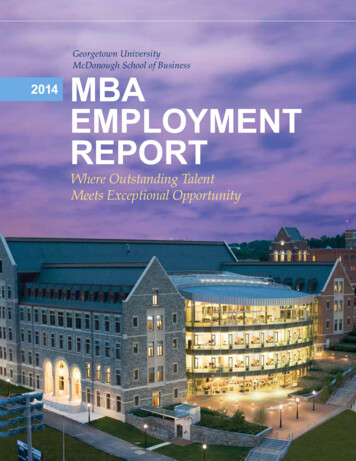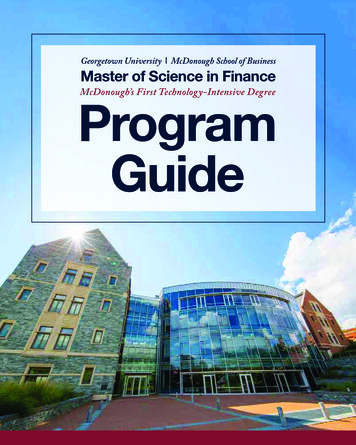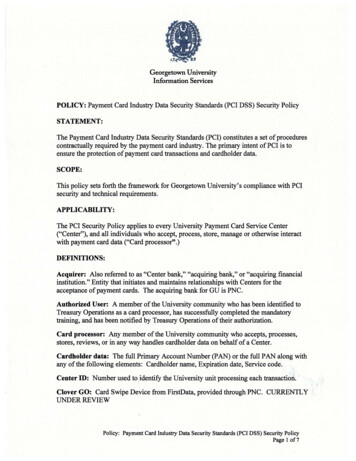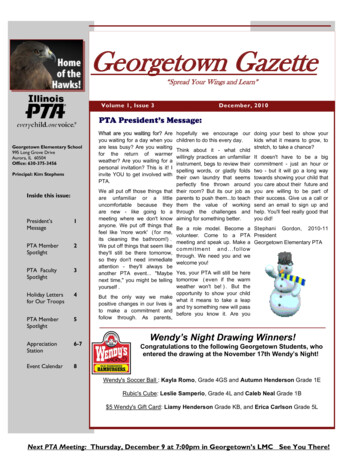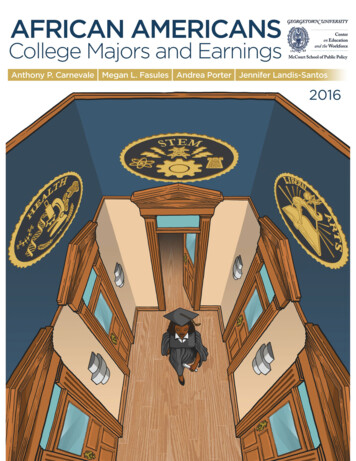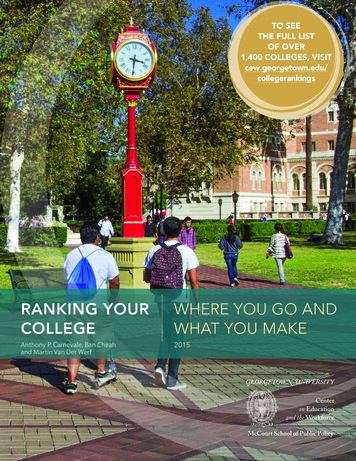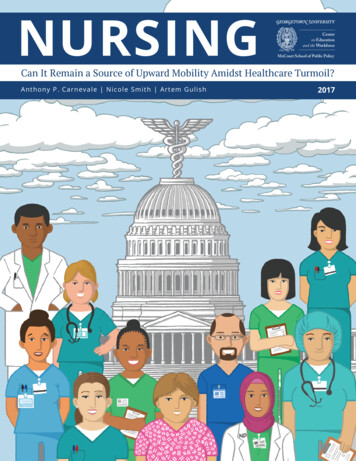
Transcription
NURSINGCenteron Educationand the WorkforceMcCourt School of Public PolicyCan It Remain a Source of Upward Mobility Amidst Healthcare Turmoil?A n thony P. Carne va l e Ni c ol e S m i th Ar t e m G ulish2017
oodbsReprint PermissionThe Georgetown University Center on Education and the Workforce carries a Creative Commons license,which permits non-commercial re-use of any of our content when proper attribution is provided.You are free to copy, display, and distribute our work, or include our content in derivative works, underthe CEW’s following conditions:Attribution: You must clearly attribute the work to the Center on EducationCCand the Workforce and provide a print or digital copy of the work tocewgeorgetown@georgetown.edu.GoodJobsOur preference is to cite figures and tables as follows:Source: Georgetown University Center on Education and the Workforce, Nursing: Can It Remain a Sourceof Upward Mobility Amidst Healthcare Turmoil?Noncommercial: You may not use this work for commercial purposes. Written permissionCCmust be obtained from the owners of the copy/literary rights and from GeorgetownUniversity for any publication or commercial use of reproductions.CCApproval: If you are using one or more of our available data representations (figures, charts,tables, etc), please visit our website at for more information.For the full legal code of this Creative Commons license, please visit www.creativecommons.org.Should you need a form to be filled out by us, please email cewgeorgetown@georgetown.edu and wewill respond in a timely manner.
Nursing: Can It Remain aSource of Upward MobilityAmidst Healthcare Turmoil?Anthony P. Carnevale, Nicole Smith, and Artem Gulish2017Centeron Educationand the WorkforceMcCourt School of Public Policy
AcknowledgementsWe are grateful to the individuals and organizations whose generous support has made this reportpossible: Lumina Foundation (Jamie Merisotis, Holly Zanville, and Susan D. Johnson), the Bill & MelindaGates Foundation (Daniel Greenstein and Janet Salm) and the Joyce Foundation (Sameer Gadkaree). We arehonored to be their partners in our shared mission of promoting postsecondary access, completion, andcareer success for all Americans.The staff of the Georgetown University Center on Education and the Workforce was instrumental in theproduction of this report from conception to publication. In particular, we would like to thank: Jeff Strohl for research directionAndrea Porter for strategic guidanceMegan Fasules, and Michael Quinn for data analysisMartin Van Der Werf and Andrew R. Hanson for editorial and qualitative feedbackHilary Strahota, Vikki Hartt, Wendy Chang, and Precious Stephens-Ihedigbo for broadcommunications efforts, including design development and public relationsJoe Leonard and Coral Castro for assistance with logistics and operationsMany others contributed their thoughts and feedback throughout the production of this report. We areespecially grateful to our talented designers, editorial advisors, and printers, whose efforts were vital toour success.The views expressed in this publication are those of the authors and do not necessarily represent those of LuminaFoundation, the Bill & Melinda Gates Foundation, the Joyce Foundation, or any of their officers or employees.
Table of Contents1Glossary3Introduction3RNs are the core of the nursing profession; they differ by highest level of education,job description, autonomy, and location of employment.6Nursing jobs are at risk as lawmakers debate healthcare reform.7What RNs Do8While the jobs available to nurses have diversified, the majority of RNs remain in traditionalhospital staff nurse positions.10Slightly more than half of registered nurses work in hospitals, and one-fifth work in the insurance,pharmaceutical, and regulatory sectors.11Nurses in advanced specialty positions work longer hours than other nurses.13Though LPN/LVN to RN transition programs exist, only about 18 percent of existing RNs werepreviously LPNs/LVNs.16Nursing competencies are complex, and they expand as nurses gain more authority.23Twice as many RNs have a BSN or higher as have an ADN/ASN or less.24RNs come to the profession and advance through many different education and experience pathways.27Registered nursing offers average annual earnings of 67,000, much higher than thosefor similarly educated women in other fields.30Nursing is still dominated by White women, though it is slowly diversifying.32Minority women are entering nursing in increasing numbers, but RNs still don’t reflect the diversityof society.35The nursing workforce is aging.36Foreign-born nurses play an increasingly important role.36Almost two out of every three foreign-born RNs have a BSN, while only one in two US-born RNshas a BSN.37More than half of foreign-born RNs now come from Asia, while just over 20 percent are fromAfrica and the Middle East.38Conclusion40References43Appendix: Nursing Jobs at Risk by State from Repeal of the Affordable Care Act
Table of Figures and Tables8Figure 1. RNs spend nearly 60 percent of their time on administrative activities that are notdirect patient care.9Figure 2. In recent decades, most registered nurses have generally held the position ofstaff nurse.10Figure 3. More than half of registered nurses work in a hospital setting (community,federal, or other).12Figure 4. Specialty RNs work longer hours than other RNs. Nurse midwives are most likelyto report working more than 40 hours per week.13Figure 5. The number of sub-baccalaureate LPN/LVN credentials awarded increased from29,000 in 1995 to nearly 50,000 in 2015.14Figure 6. Postsecondary certificates accounted for 96 percent of the LPN/LVN credentialsawarded in 2015.22Figure 7. Nurses have primarily investigative and social interests and value relationshipsand support.23Figure 8. Among RNs in the field, 66 percent held a BSN or higher in 2016.26Figure 9. The share of nurses who are working learners declines with age.26Figure 10. More than half (53%) of all working nurses enrolled in an education program areage 35 or younger.28Figure 11. RN earnings have remained higher than average earnings for all prime-ageworkers over the past few decades and are substantially higher than earnings for womenin general.28Figure 12. Registered nurses with an MSN or higher have the highest earnings, while thosewith a nursing diploma have the lowest earnings.29Figure 13. Among nursing specialties, certified registered nurse anesthetists (CRNAs)have the highest earnings, followed by nurse practitioners (NPs) and certified nursemidwives (CNMs).
30Figure 14. In 2016, the share of male RNs was three times higher than in 1980, but menmake up only about 10 percent of the RN workforce.32Figure 15. White RNs are overrepresented relative to their population share, whileminority RNs, especially Latinos, are underrepresented.33Figure 16. Nursing is diversifying from the bottom up: 43 percent of the LPN/LVNworkforce is from diverse racial and ethnic backgrounds.34Figure 17. Latinos and Blacks are more represented among RNs with associate’s degreesthan those with bachelor’s degrees.35Figure 18. As of 2016, 61 percent of all RNs were 40 or older, a 20 percentage pointincrease since 1980.36Figure 19. Foreign-born RNs are more likely to have a bachelor’s or a graduate degree.37Figure 20. Before 1960, foreign-born RNs came almost exclusively from Europe; since2000, almost 75 percent of foreign-born RNs have come from Asia and Africa.4Table 1. The range of specialty fields in nursing can result in earnings as low as 46,000or as high as 150,000 per year.18Table 2. Nurses must know medical, scientific, and social disciplines.19Table 3. Nurses must have critical thinking, sound judgment, and effectivecommunications skills.20Table 4. Nurses must have physical, mental, and social abilities necessary to care forpatients and resolve any problems that may arise.31Table 5. Male nurses are paid more than female nurses at every education level.
GlossaryThe nursing profession has many levels, relevant degrees, and specialties. This is a guide to the terms usedin this report.DNP – Doctor of Nursing Practice is a professional doctoral degree intended to establish anindividual’s expertise as a clinical practitioner. The DNP prepares an RN to manage acute andchronic medical conditions as a primary care provider, usually independent from a medical doctor.PhD/DNS – Doctor of Philosophy in Nursing or Doctor of Nursing Science is a terminal researchfocused degree in nursing. These are academic degrees intended for individuals who plan to beinvolved in teaching and research.MSN – Master of Science in Nursing is a postgraduate degree for RNs who have an interest inadministration or management within the nursing field. It is also a requirement for many advancedpractice registered nurse (APRN) specialties and in some cases is a prerequisite for the DNP.BSN – Bachelor of Science in Nursing is a four-year baccalaureate degree that, together with alicense after passing the National Council Licensure Examination-Registered Nurse (NCLEX-RN)exam, is the emerging entry-level requirement for RNs. Although not officially required, the BSNis highly favored over an Associate Degree in Nursing and as an entry-level requirement for asignificant number of registered nursing opportunities.ADN/ASN – Associate Degree in Nursing/Associate of Science in Nursing are nursing degrees thatare completed at a two-year college or a university. Together with the NCLEX-RN exam, thesedegrees make a candidate eligible to apply for licensure as an RN.Hospital-based diploma – This is an entry-level nursing credential that, together with the NCLEX-RNexam, allows one to apply for licensure as an RN. The diploma is awarded by hospital-based nursingprograms. These programs are slowly being replaced by nursing programs at other institutions,such as community colleges and nursing schools within universities. Many of the existing hospitalbased programs coordinate with nearby schools to teach classes that, together with the practicum/apprenticeship-based programs in hospitals, are required to complete the diploma.1Nursing: Can It Remain a Source of Upward Mobility Amidst Healthcare Turmoil?
OCCUPATIONSAdvanced practice registered nurses (APRNs) – Registered nurses (RNs) who completed a postgraduatedegree such as a DNP or MSN and obtained additional license or certification from their state’s board ofnursing. APRNs have greater professional autonomy than RNs and serve as leading primary or specialtyhealthcare providers (similar to doctors, physician assistants, chiropractors, or physical therapists). Thefour main types of APRNs are nurse practitioner (NP), certified registered nurse anesthetist (CRNA), certifiednurse midwife (CNM), and clinical nurse specialist (CNS).Nurse practitioner (NP) – An APRN who usually has completed a DNP program or a set ofgraduate coursework and clinical education beyond that of an RN, such as an MSN. NPs diagnosemedical conditions, order treatment, prescribe drugs, and make referrals in much the same way asphysicians. In many states, NPs do not need to practice under the supervision of a physician.Certified registered nurse anesthetist (CRNA) – An APRN who usually has completed a DNP orMSN program and is board certified in anesthesia.Certified nurse midwife (CNM) – An APRN who usually has completed a DNP or MSN programand is board certified in midwifery. CNMs specialize in the provision of care for women who areexperiencing low-risk pregnancies.Clinical nurse specialist (CNS) – An APRN who usually has completed a graduate DNP or MSNprogram in selected areas of nursing leading to board certification as a CNS. CNSs providespecialized care and are responsible for patient diagnosis and treatment as well as supervision ofRNs and other medical staff in widely varied inpatient areas, including but not limited to medicalsurgical, pediatric, perinatal, geriatric, psychiatric, rehabilitation, critical care, and emergency/trauma, as well as outpatient areas such as home health, community health, public health,occupational health, and school healthcare.Registered nurse (RN) – A nurse who has graduated from a nursing program and has passed the NCLEXRN exam. To become an RN, one must complete a bachelor’s degree (BSN), an associate’s degree (ADN/ASN), or diploma in nursing and pass the NCLEX-RN. RNs are the center of gravity among the nursingprofessions—84 percent of all nurses are RNs.Licensed practical nurse (LPN)/licensed vocational nurse (LVN) – A nursing professional who caresfor people under the direction of an RN or physician. Aspiring LPNs/ LVNs study for one to two years ata community college or a vocational/technical school and also pass the NCLEX-PN exam. No substantivedifference exists between LPNs and LVNs, except for the occupational name, which varies by state.Nursing: Can It Remain a Source of Upward Mobility Amidst Healthcare Turmoil?2
IntroductionNursing has always been a profession that offered economic and social opportunity for women. Nurses wereonce viewed as a source of inexpensive skilled female labor that moved freely across national and internationalborders. Over a century ago, nursing offered dignity, charity, income security, and religious service for thewomen who chose to leave their homes and work in the field. Today, nursing has diversified into a highlycomplex set of vocations available to both men and women who work collaboratively with physicians andpatients to care for individuals, treat illnesses, and improve quality of life. The earnings for registered nurses(RNs) remain above average for college-educated women, though they have stagnated in recent years. Despitethese concerns, the nursing profession has very well developed career pathways that offer seniority, autonomy,and opportunity as one’s education, skills, and experience improve over time.The potential overhaul of the nation’s healtcare system, however, could mean that between 22 million and24 million Americans lose health-insurance coverage by 2026. With the lost coverage, there would be acommensurate decreased demand for healthcare workers, among whom nurses are the largest group. Thisreduction would differ for metropolitan and rural regions. However, we estimate that 156,000 nursing jobswould be put at risk in 2019 alone if the Affordable Care Act is repealed and replaced.To compound the issue, the nursing workforce is aging and baby boomer nurses will eventually retire. This willincrease opportunities for more diverse, gender mixed, and more highly educated incoming cohorts.RNs are the core of the nursing profession; theydiffer by highest level of education, job description,autonomy, and location of employment.Registered nurses (RNs) are the core of the nursing profession. They are the largest category of nurses(84%) and are involved in all facets of healthcare delivery. RNs must complete a bachelor’s degree (BSN), anassociate’s degree (ADN/ASN), or a diploma in nursing and obtain a test-based credential in the form of anRN license from their state’s board of nursing. Each state board of nursing requires passing the NCLEX-RNexam. Also, advanced degrees and specific certifications, such as advanced cardiac life support and medicalcoding, are increasingly common credentials among RNs.3Nursing: Can It Remain a Source of Upward Mobility Amidst Healthcare Turmoil?
The most highly educated nurses with the greatest degree of autonomy are advanced practice registerednurses (APRNs), with postgraduate levels of education and training. These nurses start out as RNs andremain part of the RN workforce. By completing a postgraduate education program—either a Doctor ofNursing Practice (DNP) or Master of Science in Nursing (MSN) in advanced nursing specialties, such as nursepractitioner (NP), certified registered nurse anesthetist (CRNA), certified nurse midwife (CNM), or clinicalnurse specialist (CNS)—and obtaining additional licensure or certification from their state’s board of nursing,APRNs attain more advanced positions and greater professional autonomy.APRNs serve as leading primary or specialty care providers (similar to doctors, physician assistants,chiropractors, and physical therapists). The four main specialties among APRNs are nursepractitioner (NP), certified registered nurse anesthetist (CRNA), certified nurse midwife (CNM), andclinical nurse specialist (CNS), who work with relative autonomy in a wide variety of inpatient andoutpatient practice areas from emergency/trauma to home care.Licensed practical nurses (LPNs) and licensed vocational nurses (LVNs) provide basic essentialmedical care under the supervision of RNs and have the lowest entry-level requirements. Nosubstantive difference exists between LPNs and LVNs except for the occupational nomenclature,which depends on the state in which these nurses practice. LPNs/LVNs provide direct care topatients under the direction of RNs and physicians. At a minimum, LPNs/LVNs must obtain apostsecondary certificate, usually at a community college, and a test-based license credential, whichrequires passing the NCLEX-PN exam.The required levels of education, training, certification, and autonomy result in varying earnings fornurses (Table 1).Table 1. The range of specialty fields in nursing can result in earnings as low as 46,000 or as highas 150,000 per year.NURSING OCCUPATIONAL GROUPSNursing occupationalgroupsDegree requiredCertification/license requiredShare of nursingworkforce (%)Average earnings(2015 )Registered nurse (RN)BSN, ADN, or NursingDiplomaState licensure;NCLEX-RN Exam8467,000Licensed practical nurse/licensed vocational nurse(LPN/LVN)Postsecondary certificate,associate’s degreeState licensure;NCLEX-PN Exam1646,000111 The earnings for RNs and LPNs/LVNs are for prime-age (25-54), full-time, full-year workers, based on Georgetown University Center on Education and theWorkforce analysis of US Census Bureau and Bureau of Labor Statistics, Current Population Survey (CPS) March Supplement data, 1980-2015. US Bureau of LaborStatistics, Occupational Employment Statistics (OES), 2015 annual mean earning estimate for RNs is 71,000. OES earning estimates are based on a survey ofemployer establishments, whereas CPS earning estimates are based on a survey of households. OES excludes the self-employed, household workers, unpaidfamily workers, and owners and partners within unincorporated firms. OES annual earning estimates are based on multiplying hourly mean earnings by 2,080hours (full-time, full-year). OES excludes nurse anesthetists, nurse practitioners, and nurse midwives from the RN occupational category.Nursing: Can It Remain a Source of Upward Mobility Amidst Healthcare Turmoil?4
REGISTERED NURSES POSITIONS AND SPECIALTIESRN positions and specialtiesCertification/licenses requiredDegree requiredShare ofRNs (%)Average earnings(2015 )Predominant RN positionsStaff nurseBSN, ADN, or NursingDiplomaState licensure;NCLEX-RN exam56*60,000Acute/critical care nurseBSN, ADN, or MSNState licensure;NCLEX-RN Exam670,000383,000*2Advanced Practice RNs (APRNs)3Nurse practitioner (NP)MSN, PhD, DNP, or DNSAPRN certificationCertified nurse midwife(CNM)MSN, PhD, DNP, or DNSAPRN certificationCertified registered nurseanesthetist (CRNA)MSN, PhD, DNP, or DNSAPRN certification1153,000*Clinical nurse specialist(CNS)MSN, PhD, DNP, or DNSAPRN certification175,000*4Other Advanced RN Specialties5Nursing instructorMSN, PhD, DNP, or DNSAPRN certification CNE#362,000*Nursing researcherMSN, PhD, DNP, or DNSState licensure168,000*2345Note: Share of RNs column does not add up to 100 percent because only major categories of RNs are presented in the table; omittednursing positions include nurse consultant, management/administration, private duty nurse, and various other nursing positions with smallconcentrations of RNs.* The earnings for staff nurse, NP, CNM, CRNA, CNS, nursing instructor, and nursing researcher are from 2008 National Sample Survey ofRegistered Nurses (NSSRN), updated for inflation to 2015 .#CNE – Certification for Nurse EducatorsSource: Georgetown University Center on Education and the Workforce analysis of data and information from various sources, includingHealth Resources and Services Administration (HRSA), National Sample Survey of Registered Nurses (NSSRN), 2008; US Census Bureau, AmericanCommunity Survey (ACS), 2015. Employment and Training Administration, Occupational Information Network (O*NET), 2017; US CensusBureau and Bureau of Labor Statistics, Current Population Survey (CPS) March Supplement, 2016; US Bureau of Labor Statistics, OccupationalEmployment Statistics (OES), 2015; US Bureau of Labor Statistics. Occupational Outlook Handbook, 2012; The National Forum of State NursingWorkforce Centers and the National Council of State Boards of Nursing, 2015 National Nursing Workforce Study, 2015; and The Society ofCritical Care Medicine, Compensation of Critical Care Nurses, 2009.2 According to the Society of Critical Care Medicine, Compensation of Critical Care Nurses Second Edition, 2009, the more advanced CNSs in critical care earn onaverage 81,000 a year.3 The earnings for nursing specialties are from 2008 National Sample Survey of Registered Nurses (NSSRN), updated for inflation to 2015 . The OES earning fornurse practitioners is 101,000 and for nurse midwives is 94,000 in 2015 .4 The earnings for nursing specialties are from 2008 National Sample Survey of Registered Nurses (NSSRN), updated for inflation to 2015 . The OES mean annualearning for nurse anesthetists is 160,000.5 The earnings for nursing specialties are from 2008 National Sample Survey of Registered Nurses (NSSRN), updated for inflation to 2015 . The OES earning forpostsecondary nursing instructors and teachers is 73,000 in 2015 .5Nursing: Can It Remain a Source of Upward Mobility Amidst Healthcare Turmoil?
Nursing jobs are at risk as lawmakers debatehealthcare reform.Demand for healthcare workers in general and the nursing workforce in particular remains fluid aslegislative and regulatory efforts to repeal and replace the Affordable Care Act (ACA),6 commonly known asObamacare, continue. The most contentious of the proposed adjustments to the healthcare bill involvesremoving substantial expansions of Medicaid services and subsidies for private insurance companies tocreate state exchanges and marketplaces. Nonpartisan analyses of the implications7 of this proposal suggestthat repealing those pieces of the ACA would result in the loss of millions of jobs8—both directly related tohealthcare and downstream jobs. This would result in a significant contraction of state economies.9 Theexact impact of any legislation will depend on specifics of the bill and is currently unknown. Nonetheless, inJanuary 2017, the Commonwealth Fund released estimates of potential job loss from repeal of tax creditsand Medicaid expansion by industry for each state.10Based on those projections, we estimated that 156,000 nursing jobs will be put at risk if the Affordable CareAct is repealed and replaced (for numbers of nursing jobs at risk in 2019 alone from the proposal to repealand replace the Affordable Care Act, see the Appendix).11 These include 91,000 jobs in states that were wonby Donald Trump and 65,000 jobs in states that were won by Hillary Clinton in the 2016 presidential election.These job losses would result from a lower demand for healthcare services due to a loss of health insurancecoverage for millions of people.126 The Commonwealth Fund analysis is based on the repeal of the Affordable Care Act only.7 Ku et al., “Repealing Federal Health Reform,” 2017.8 The Congressional Budget Office estimates that 23 million people will lose health coverage under American Healthcare Act as passed by the House ofRepresentatives. Congressional Budget Office, “H.R.1628, American Healthcare Act of 2017: Cost Estimate,” 2017.9 Lucia and Jacobs, California’s Projected Economic Losses under ACA Repeal, 2016.10 Ku et al., “Repealing Federal Health Reform,” 2017.11 Source: Georgetown University Center on Education and the Workforce analysis based on Ku et al., “Repealing Federal Health Reform,” 2017, and US CensusBureau, American Community Survey data, 2015.12 The Congressional Budget Office estimated that 23 million people will lose health insurance coverage if the American Healthcare Act goes into effect.Congressional Budget Office, “H.R.1628, American Healthcare Act of 2017: Cost Estimate,” 2017.Nursing: Can It Remain a Source of Upward Mobility Amidst Healthcare Turmoil?6
What RNs DoNurses are involved in nearly all aspects of healthcare delivery.13 They perform a variety of functions fromdocumentation to direct patient care and education:Documentation Record symptoms and medical histories Record administered treatment and medicationsMedication administration Administer medications and treatmentCare coordination Coordinate care Serve as managers and administrators Consult with doctors and other healthcare providers Participate in hospitals’ continuous quality improvement and patient safety programsPatient activities Educate patients and their families about specific conditions and treatment as well asmanagement plans for those conditions Act as patient advocates Provide public education on warning signs and symptoms of major illnesses Oversee immunization clinics and blood drives Direct local health department outreach programsPatient assessment and reading of vital signs Perform physical exams Perform and analyze diagnostic tests13 American Nurses Association, “What is Nursing?” 2012.7Nursing: Can It Remain a Source of Upward Mobility Amidst Healthcare Turmoil?
Figure 1. RNs spend nearly 60 percent of their time on administrative activities that are notdirect patient care.7%DocumentationMedical administrationCare coordination19%35%Patient activitiesPatient assessment andreading of vital signsSource: Hendrich et al., “A 36-HospitalTime and Motion Study,” 2008.21%17%Despite improvements in electronic recording of patient information, more than a third of nurses’ time isstill spent on documentation.14 The administration of medications takes less than a fifth of nurses’ time,while patient assessment and reading of vital signs accounts for less than one-tenth of their time. Theamount of time that a nurse spends with a patient decreases as the nurse’s seniority15 and autonomyincreases. This means that an LPN/LVN has much more hands-on time administering care to patients thando RNs and APRNs.While the jobs available to nurses have diversified, the majority ofRNs remain in traditional hospital staff nurse positions.Since the 1980s, “staff nurse” has been the most widely held position among RNs. In the most recent surveyavailable on the national distribution of nursing fields, 56 percent of RNs were staff nurses in 2008, up from50 percent in 2000 (Figure 2). A staff nurse works in a hospital and can perform a variety of roles. The shareof nurses in management and administration declined slowly from 14 percent in 1980 to 11 percent in 2008.14 Hendrich et al., “A 36-Hospital Time and Motion Study”, 2008.15 The term ”seniority” in this report refers to seniority of position, not years of experience in nursing. For example, an APRN would have more seniority than anRN and an RN would have more seniority than an LPN/LVN, regardless of how many years of experience each has in nursing.Nursing: Can It Remain a Source of Upward Mobility Amidst Healthcare Turmoil?8
Figure 2. In recent decades, most registered nurses have generally held the position of staff nurse.RNs by position, 1980-2008Other/NA23%28%1%2%24%29%1%3%Private duty/no title1%1%3%Clinical nurse specialist/nurse clinicianResearcher3%3%Nurse anesthetistNurse practitioner/certified nurse midwifeStaff 2008Note: Percentages do not total 100 and the omission of value labels for some very small categories (1% or less of RNs in each) from thechart for better readability.* A staff nurse is an RN who works in a hospital setting and can be assigned to any one of the following units: Emergency Department,Intensive Care, Labor and Delivery, Medical-Surgical, Operating Room/Recovery Room, Outpatient Services, and Pediatrics.Source: Georgetown University Center on Education and the Workforce analysis of Health Resources and Services Administration (HRSA),National Sample Survey of Registered Nurses (NSSRN), 1980-2008; 2008 was the last year this survey was administered.9Nursing: Can It Remain a Source of Upward Mobility Amidst Healthcare Turmoil?
Slightly more than half of registered nurses work in hospitals, and onefifth work in the insurance, pharmaceutical, and regulatory sectors.Registered nurses have many choices about where to work. Most often, they use their expertise in traditionalsettings, such as hospitals, nursing homes and rehabilitation centers, ambulatory care facilities, schools, andcommunity and public healthcare facilities. They also can be employed in nontraditional settings, such ascommunity-based centers, homeless shelters, and elderly care facilities.Figure 3. More than half of registered nurses work in a hospital setting (community, federal, or other).RNs by work setting, 200843%Community hospitalInsurance, rm care(not hospital-based)10%Ambulatory care (not hospitalor community-based)8%Other type of hospital8%Community-based careAcademic programFederal government hospital7%3%2%Note: Community hospitals are general medical hospitals that provide emergency, inpatient, and ambulatory care for a wide range of patients. Federal government hospitals are hospitals operated by the federal government, including the military, Veteran’s Administration (VA),National Institute
Nursing jobs are at risk as lawmakers debate healthcare reform. . RNs come to the profession and advance through many different education and experience pathways. Registered nursing offers average annual earnings of 67,000, much higher than those . Nurses must have critical thinking, sound judgment, and effective communications skills.




